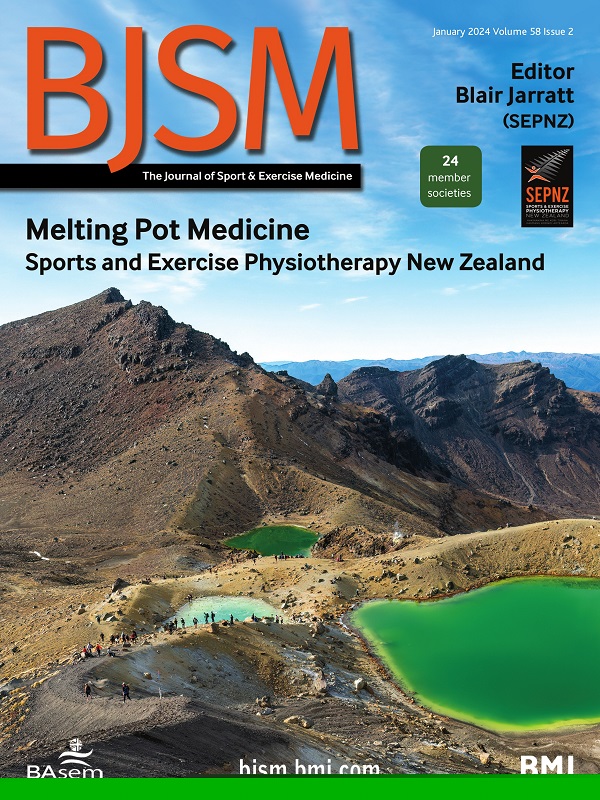Psychometric validation of the Copenhagen Hip and Groin Outcome Score (HAGOS) and Oxford Hip Score (OHS) in patients with hip-abductor tendon pathology
IF 11.6
1区 医学
Q1 SPORT SCIENCES
引用次数: 0
Abstract
Objective Validated patient-reported outcome measures for patients with hip-abductor tendon pathology are lacking. Recent studies indicate that the Copenhagen Hip and Groin Outcome Score (HAGOS), in the original or the revised scoring format, and the Oxford Hip Score (OHS) may be relevant for use in patients with hip-abductor tendon pathology. The objective of this study was to assess the validity of the Danish version of the HAGOS, the revised HAGOS, and the OHS psychometrically in patients with hip-abductor tendon pathology. This involved the six subscales in the original and the revised version of HAGOS, the standard one-factor scoring of the OHS and the two-factor scoring of the OHS. Methods We included individual responses to HAGOS and OHS from 210 patients with hip-abductor tendon pathology (17 men; 193 women; median age 56 years, range 18–91, IQR 48–65). Overall fit, model fit, individual item fit and measurement invariance were examined using confirmatory factor analysis (CFA) and item response theory. Results CFA rejected psychometric validity of three original HAGOS subscales (symptoms, pain, physical function in sport and recreation) (p<0.0001) and the OHS (p<0.0001), whereas the revised scoring format for HAGOS subscales fit adequately. Results indicate a notable discrepancy between observed and expected scores on OHS item 10 in the patient group. Conclusion The original HAGOS and OHS are not psychometrically valid, but the revised HAGOS scoring format is an appropriate PROM for patients with hip-abductor tendon pathology. The OHS would need slight adjustment before being used in patients with hip-abductor tendon pathology. Data are available upon reasonable request. Fully anonymised data are available from the corresponding author upon request.哥本哈根髋关节和腹股沟结果评分(HAGOS)和牛津髋关节评分(OHS)在髋关节内收肌腱病变患者中的心理计量验证
目的目前缺乏经患者报告的髋外展肌腱病变的疗效指标。最近的研究表明,哥本哈根髋关节和腹股沟结局评分(HAGOS),无论是原始的还是修订的评分格式,以及牛津髋关节评分(OHS)可能与髋外展肌腱病理患者的使用相关。本研究的目的是评估丹麦版HAGOS、修订后的HAGOS和OHS在髋外展肌腱病理患者的心理测量学有效性。这涉及到原HAGOS和修订版HAGOS中的6个分量表、职业健康安全标准单因素评分和职业健康安全标准双因素评分。方法我们收集了210例髋外展肌腱病变患者对HAGOS和OHS的个体反应(男性17例;193名女性;中位年龄56岁,范围18-91岁,IQR 48-65岁)。采用验证性因子分析和项目反应理论对整体拟合、模型拟合、单项拟合和测量不变性进行检验。结果CFA拒绝了三个原始HAGOS子量表(症状、疼痛、运动和娱乐中的身体功能)和OHS (p<0.0001)的心理测量效度,而修订后的HAGOS子量表的评分格式符合得很好。结果显示,患者组的OHS第10项得分与预期得分存在显著差异。结论原来的HAGOS和OHS评分格式在心理测量学上不有效,但修订后的HAGOS评分格式对髋外展肌腱病变患者是一种合适的PROM。OHS在用于有髋外展肌腱病变的患者之前需要稍作调整。如有合理要求,可提供资料。完全匿名的数据可根据要求从通讯作者处获得。
本文章由计算机程序翻译,如有差异,请以英文原文为准。
求助全文
约1分钟内获得全文
求助全文
来源期刊
CiteScore
27.10
自引率
4.90%
发文量
217
审稿时长
3-8 weeks
期刊介绍:
The British Journal of Sports Medicine (BJSM) is a dynamic platform that presents groundbreaking research, thought-provoking reviews, and meaningful discussions on sport and exercise medicine. Our focus encompasses various clinically-relevant aspects such as physiotherapy, physical therapy, and rehabilitation. With an aim to foster innovation, education, and knowledge translation, we strive to bridge the gap between research and practical implementation in the field. Our multi-media approach, including web, print, video, and audio resources, along with our active presence on social media, connects a global community of healthcare professionals dedicated to treating active individuals.

 求助内容:
求助内容: 应助结果提醒方式:
应助结果提醒方式:


